Leaf drop has been slow and erratic at Shibui Bonsai this year. Some of the maples still have leaves but many of the tridents are now bare. that gives the perfect opportunity to review ramification and make alterations. Continue reading
Bonsai Week
I was fortunate to get a place with Tony Tickel at this year’s Bonsai week workshops. Thanks to the National Bonsai and Penjing Collection of Australia for making these bonsai activities possible. I think everyone who attended took home a lot of new information and ideas.
I finally decided to take an old black pine. I’ve had a couple of these trees since they were small seedlings but because I did not understand pine maintenance techniques properly they both gradually grew long, bare branches with foliage only at the tips. The trunks are thick and have mature bark which is highly desirable in pines. This one also has a large, spreading root mass so I thought it was worth taking some time and effort to try to resurrect it for bonsai.
I have spent the last 7 years forcing the foliage closer to the trunk to make the trees more compact. Pruning stimulated a few back buds on bare wood which were then nurtured until strong enough to remove the longer branches. I also resorted to grafting and inarching to get growth on other branches that had refused to bud.
Here is the tree before the workshop.
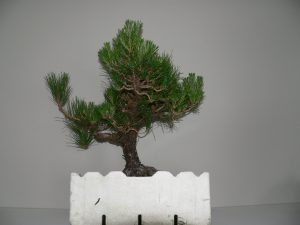
Black pine before
You can see that there was plenty of branches and foliage to choose from. The tree was well fed and healthy to cope with a major restyle.
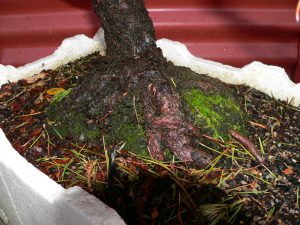
black pine nebari
After checking several options we decided to try to keep the current front because the nebari on this side is far better than the other side.
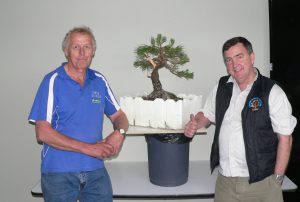
After
There were several options for trunk lines and we have used a fairly standard informal upright trunk line with some jin and shari.
The first branch had a really nice shape but was far too heavy for the remainder of the tree so it was 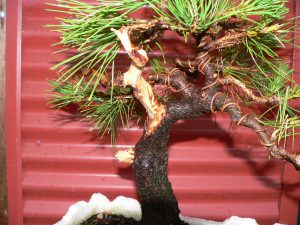 removed leaving a short jin.
removed leaving a short jin.
The apex of the tree leaned too far forward and was an awkward shape so it was also jinned. Because the old main trunk was so strong it had thickened the trunk in that area giving a slight reverse taper to the new trunk so a small area of shari surrounds the jin to reduce the visual weight and maintain better visual taper.
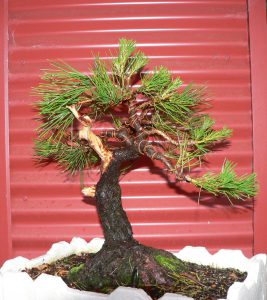
After the worshop
Spring should see this pine grow strongly. I’ll begin my pine maintenance schedule with this one now to try to maintain density and promote inner buds – Early summer candle pruning and needle plucking followed by autumn thinning and more needle plucking should produce more even energy distribution and promote shorter growth and smaller needles.
Shari!
‘Shari’ is the Japanese term for dead wood along the trunk of a bonsai. Dead tips of branches are referred to as ‘jin’. Continue reading
Juniper pre bonsai
The shimpaku junipers I dug from the grow beds last winter have finally decided they are going to survive the trauma and have plenty of new roots and good growth on top. Continue reading
shibuibonsai.com.au has moved
We recently moved shibuibonsai.com.au to a new server. It appears that not all the images I have used in the posts have survived the move. It will take me some time to replace the missing files. In the meanwhile you will just have to use your imaginations to fill out the visual details of some of the posts. Please let me know if you have found a post that is vital to you and desperately needs the images to make sense and I’ll see if I can fast track replacing those files.
Apologies for the inconvenience and thanks for your patience.
Neil
Banksia and fertiliser
For many years there has been a myth that ‘normal’ fertiliser will kill Australian plants.
The truth is that most Aussie natives don’t care. Many actually grow way better when they have access to reasonable levels of P so they grow better when fertilised with standard fertilisers. I have actually come to the conclusion that many of my early failures with Australian native plants can be attributed to starvation because I was too frightened to fertilise. Continue reading
Repotting natives
I usually repot any native plants in November or December. There were plenty that needed doing this season because I had not repotted for a couple of years. I find that many native plants grow lots of fine roots in the pots and quickly get to the stage where there is no room in the potting mix for water or air to penetrate. This mans that it becomes increasingly difficult to keep the mix hydrated and I have lost quite a few trees because I have not repotted often enough. Continue reading
2016-17 Catalogue
Spring has been very busy for Shibui Bonsai. We had a trade table at Canberra Bonsai Society show and supplied more stock for Bonsai North West spring show in Melbourne at the start of November. Our local Albury Wodonga Bonsai Society staged exhibitions at both Albury Show and Myrtleford show.
Now that spring is over I have finally managed to find time to take photos of the trees on the sales tables and get them up on the Catalogue page. No descriptions yet this time but I think you can probably get a pretty good idea of the trees from the pictures. Just email neil@shibuibonsai.com.au if you need more info on any of the trees featured.
Spring flowering – Crab Apple
Spring seems to have started slowly here at Shibui Bonsai. Lots of rain keeping temps a little lower than usual but the trees have responded to the warmth and started to grow. Continue reading
Springtime!
After a wet winter the longer, warmer days of Spring are welcome. It is always magical to see the new leaves start to open and flower buds swelling so I thought I’d share some photos with you. Continue reading
